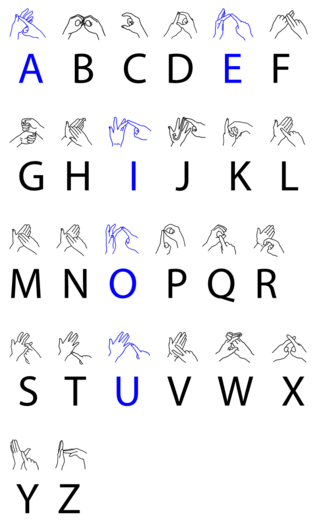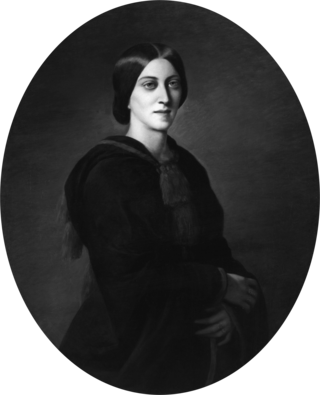Related Research Articles

Sign languages are languages that use the visual-manual modality to convey meaning, instead of spoken words. Sign languages are expressed through manual articulation in combination with non-manual markers. Sign languages are full-fledged natural languages with their own grammar and lexicon. Sign languages are not universal and are usually not mutually intelligible, although there are also similarities among different sign languages.

International Sign (IS) is a pidgin sign language which is used in a variety of different contexts, particularly at international meetings such as the World Federation of the Deaf (WFD) congress, in some European Union settings, and at some UN conferences, at events such as the Deaflympics, the Miss & Mister Deaf World, and Eurovision, and informally when travelling and socialising.

British Sign Language (BSL) is a sign language used in the United Kingdom (UK), and is the first or preferred language among the Deaf community in the UK. Based on the percentage of people who reported 'using British Sign Language at home' on the 2011 Scottish Census, the British Deaf Association estimates there are 151,000 BSL users in the UK, of which 87,000 are Deaf. By contrast, in the 2011 England and Wales Census 15,000 people living in England and Wales reported themselves using BSL as their main language. People who are not deaf may also use BSL, as hearing relatives of deaf people, sign language interpreters or as a result of other contact with the British Deaf community. The language makes use of space and involves movement of the hands, body, face, and head.
Finnish poetry is the poetry from Finland. It is usually written in the Finnish language or Swedish language, but can also include poetry written in Northern Sámi or other Sámi languages. It has its roots in the early folk music of the area, and still has a thriving presence today.
Dorothy "Dot" Miles was a Welsh poet and activist in the deaf community. Throughout her life, she composed her poems in English, British Sign Language, and American Sign Language. Her work laid the foundations for modern sign language poetry in the United States and the United Kingdom. She is regarded as the pioneer of BSL poetry and her work influenced many contemporary Deaf poets.
Northern Ireland Sign language (NISL) is a sign language used mainly by deaf people in Northern Ireland.
Old Kentish Sign Language was a village sign language of 17th-century Kent in the United Kingdom, that has been incorporated along with other village sign languages into British Sign Language.
Michael Davidson is an American poet.

Jim Cohn is a poet, poetry activist, and spoken word artist in the United States. He was born in Highland Park, Illinois, in 1953. Early poetics and musical influences include Bob Dylan, the subject of a now lost audiotaped for a class project completed in his senior year at Shaker Heights High School, where he also co-captained the varsity football team. He received a BA from the University of Colorado at Boulder in English (1976) and a Certificate of Poetics (1980) from the Jack Kerouac School of Disembodied Poetics at Naropa University where he was a teaching assistant to Allen Ginsberg. He received his M.S. Ed. in English and Deaf Education from the University of Rochester and the National Technical Institute for the Deaf (NTID) in 1986. For over two decades, he worked in the field of disability services, taking a siddha approach as a model of Disability Services and Studies practice and scholarship. He believed that the social sciences should be redefined thematically within the United States into a form of American Karmic Studies.
American Sign Language literature is one of the most important shared cultural experiences in the American Deaf community. Literary genres initially developed in residential Deaf institutes, such as American School for the Deaf in Hartford, Connecticut, which is where American Sign Language developed as a language in the early 19th century. There are many genres of ASL literature, such as narratives of personal experience, poetry, cinematographic stories, folktales, translated works, original fiction and stories with handshape constraints. Authors of ASL literature use their body as the text of their work, which is visually read and comprehended by their audience viewers. In the early development of ASL literary genres, the works were generally not analyzed as written texts are, but the increased dissemination of ASL literature on video has led to greater analysis of these genres.
In sign languages, the term classifier construction refers to a morphological system that can express events and states. They use handshape classifiers to represent movement, location, and shape. Classifiers differ from signs in their morphology, namely in that signs consist of a single morpheme. Signs are composed of three meaningless phonological features: handshape, location, and movement. Classifiers, on the other hand, consist of many morphemes. Specifically, the handshape, location, and movement are all meaningful on their own. The handshape represents an entity and the hand's movement iconically represents the movement of that entity. The relative location of multiple entities can be represented iconically in two-handed constructions.

Valerie Sutton is an American developer of movement notation and a former dancer.

Adelaide Anne Procter was an English poet and philanthropist.

Pierre Pélissier was a pioneer for deaf education in France in the mid-19th century. He was born September 22, 1814, in Gourdon, Lot, and died April 30, 1863. He was a teacher of the deaf and also wrote a dictionary for an early form of French Sign Language in 1856. He studied first at Rodez and Toulouse, under Abbot Chazottes. He then became a teacher at the School of the Deaf in Toulouse. He was the deputy secretary of the Central Society for Deaf Mutes in Paris in 1842. At 29, in 1843, he went to Paris to teach at the Imperial School for Deaf Mutes, until his death.
Bencie Woll, FBA, FAAAS is an American–British linguist and scholar of sign language. She became the first professor of sign language in the United Kingdom when she was appointed Professor of Sign Language and Deaf Studies at City University, London in 1995. In 2005, she moved to University College London where she became Professor of Sign Language and Deaf Studies and Director of the Deafness, Cognition and Language Research Centre (DCAL).

The Silent Child is a British sign language short film written by and starring Rachel Shenton and directed by Chris Overton, and released in 2017 by Slick Films. It tells the story of Libby, a profoundly deaf 6-year-old girl, who lives a silent life until a social worker, played by Shenton, teaches her how to communicate through sign language. The film won the Oscar for Live Action Short Film at the 90th Academy Awards. The film's television debut was on BBC One to an audience of 3.6 million, the film then received an extended period on BBC iPlayer.

Raymond Antrobus is a British poet, educator and writer, who has been performing poetry since 2007. In March 2019 he won the Ted Hughes Award for new work in poetry. In May 2019, Antrobus became the first poet to win the Rathbones Folio Prize for his collection The Perseverance, praised by chair of the judges as "an immensely moving book of poetry which uses his deaf experience, bereavement and Jamaican-British heritage to consider the ways we all communicate with each other." Antrobus was elected a Fellow of the Royal Society of Literature in 2020.
John Lee Clark is an American deafblind poet, writer, and activist from Minnesota. He is the author of Suddenly Slow (2008) and Where I Stand: On the Signing Community and My DeafBlind Experience (2014), and the editor of anthologies Deaf American Poetry (2009) and Deaf Lit Extravaganza (2013). Clark was the recipient of a 2020 National Magazine Award. He is a prominent activist in the Protactile movement.
Judith Collins was a university lecturer and researcher at Durham University. She was Deaf and a British Sign Language user.

A nonmanual feature, also sometimes called nonmanual signal or sign language expression, are the features of signed languages that do not use the hands. Nonmanual features are gramaticised and a necessary component in many signs, in the same way that manual features are. Nonmanual features serve a similar function to intonation in spoken languages.
References
- ↑ "Signing Hands Across The Water Website".
- ↑ Sutton-Spence, Rachel; Müller de Quadros, Ronice (2014). ""I Am The Book"—Deaf Poets' Views on Signed Poetry". The Journal of Deaf Studies and Deaf Education. 19 (4): 546–558. doi: 10.1093/deafed/enu020 . PMID 25100082.
- ↑ Sutton-Spence, Rachel (2005). "Five Senses and Three Queens". In Palgrave Macmillan, London (ed.). Analysing Sign Language Poetry. Vol. Analysing Sign Language Poetry. pp. 199–224. doi:10.1057/9780230513907_13. ISBN 978-0-230-21709-6.
- ↑ Sutton-Spence, Rachel (2010). "The Role of Sign Language Narratives in Developing Identity for Deaf Children". Journal of Folklore Research. 47 (3): 265–305. doi:10.2979/jfolkrese.2010.47.3.265. S2CID 145236959.